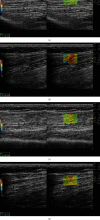The Value of Real-Time Shear Wave Elastography before and after Rehabilitation of Upper Limb Spasm in Stroke Patients
- PMID: 32923483
- PMCID: PMC7453236
- DOI: 10.1155/2020/6472456
The Value of Real-Time Shear Wave Elastography before and after Rehabilitation of Upper Limb Spasm in Stroke Patients
Abstract
Objective: Our goal was to evaluate the efficacy of muscle spasm before and after rehabilitation by comparing shear wave propagation velocity (SWV) and Young's modulus (YM) in the normal and spastic biceps brachii in stroke patients.
Methods: A study of 60 stroke patients with upper limb spasm was performed; these patients were admitted from April 2018 to September 2019. The modified Ashworth scale (MAS) scores of the spastic biceps brachii before and after rehabilitation treatment were compared. SWV and YM on the spastic and normal biceps brachii before rehabilitation treatment, SWV and YM on the spastic and normal biceps brachii after rehabilitation treatment, and SWV and YM on the spastic biceps brachii before and after rehabilitation treatment were compared. Whether SWV and YM on the spastic biceps brachii are related to MAS was compared.
Results: There was a statistically significant difference in SWV and YM between the normal and spastic biceps brachii before (P < 0.01) and after (P < 0.05) the rehabilitation treatment. There was no statistically significant difference in SWV and YM in the normal biceps brachii before and after the rehabilitation treatment (P > 0.05). There was a statistically significant difference in SWV and YM in the spastic biceps brachii before and after the rehabilitation treatment (P < 0.01). SWV and FM of the spastic biceps brachii are correlated with MAS before and after rehabilitation treatment, and the correlation coefficient for SWV was 0.563 and 0.605 for YM (P < 0.05).
Conclusion: SWE can be used as a means of assessment before and after rehabilitation treatment.
Copyright © 2020 Jun Liu et al.
Conflict of interest statement
There are no conflicts of interest with all the authors.
Figures

Similar articles
-
Quantitative Ultrasound Imaging to Assess the Biceps Brachii Muscle in Chronic Post-Stroke Spasticity: Preliminary Observation.Ultrasound Med Biol. 2018 Sep;44(9):1931-1940. doi: 10.1016/j.ultrasmedbio.2017.12.012. Epub 2018 Feb 2. Ultrasound Med Biol. 2018. PMID: 29398131
-
Evaluation of Post-Stroke Spastic Muscle Stiffness Using Shear Wave Ultrasound Elastography.Ultrasound Med Biol. 2017 Jun;43(6):1105-1111. doi: 10.1016/j.ultrasmedbio.2016.12.008. Epub 2017 Mar 9. Ultrasound Med Biol. 2017. PMID: 28285729
-
Ultrasound shear wave elastography in assessment of muscle stiffness in patients with Parkinson's disease: a primary observation.Clin Imaging. 2016 Nov-Dec;40(6):1075-1080. doi: 10.1016/j.clinimag.2016.05.008. Epub 2016 May 29. Clin Imaging. 2016. PMID: 27408992
-
Shear wave elastography potential to characterize spastic muscles in stroke survivors: Literature review.Clin Biomech (Bristol). 2020 Feb;72:84-93. doi: 10.1016/j.clinbiomech.2019.11.025. Epub 2019 Nov 28. Clin Biomech (Bristol). 2020. PMID: 31846849 Review.
-
Ultrasound Elastography in the Assessment of the Stiffness of Spastic Muscles: A Systematic Review.Ultrasound Med Biol. 2021 Jun;47(6):1448-1464. doi: 10.1016/j.ultrasmedbio.2021.01.031. Epub 2021 Mar 8. Ultrasound Med Biol. 2021. PMID: 33707090
Cited by
-
Effectiveness of radial extracorporeal shock wave therapy in post-stroke spasticity patients: Evaluation with shear wave elastography.Turk J Phys Med Rehabil. 2024 Dec 27;71(2):206-215. doi: 10.5606/tftrd.2025.14800. eCollection 2025 Jun. Turk J Phys Med Rehabil. 2024. PMID: 40740180 Free PMC article.
-
Ultrasound elastography in the assessment of post-stroke muscle stiffness: a systematic review.Insights Imaging. 2022 Apr 5;13(1):67. doi: 10.1186/s13244-022-01191-x. Insights Imaging. 2022. PMID: 35380302 Free PMC article. Review.
-
Shear wave elastography combined with electromyography to assess the effect of botulinum toxin on spastic dystonia following stroke: A pilot study.Front Neurol. 2022 Oct 10;13:980746. doi: 10.3389/fneur.2022.980746. eCollection 2022. Front Neurol. 2022. PMID: 36299267 Free PMC article.
-
Stiffness changes in internal rotation muscles of the shoulder and its influence on hemiplegic shoulder pain.Front Neurol. 2023 Jun 2;14:1195915. doi: 10.3389/fneur.2023.1195915. eCollection 2023. Front Neurol. 2023. PMID: 37332999 Free PMC article.
-
The Sonoelastography and Functional Outcome of Upper Extremity after Kinesiotaping on the Spastic Forearm in Patients with Subacute Stroke.Biomed Res Int. 2023 Jan 16;2023:1730491. doi: 10.1155/2023/1730491. eCollection 2023. Biomed Res Int. 2023. PMID: 36700238 Free PMC article.
References
MeSH terms
LinkOut - more resources
Full Text Sources
Medical
Miscellaneous

